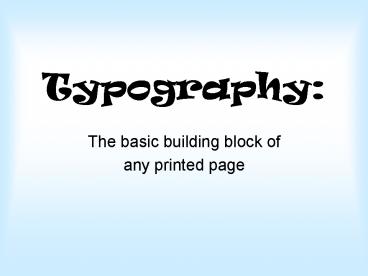Typography: - PowerPoint PPT Presentation
1 / 34
Title:
Typography:
Description:
Title: Type Author: Kelly L. Coxe Last modified by: rlincoln1 Created Date: 1/1/2003 11:54:50 PM Document presentation format: On-screen Show (4:3) Company – PowerPoint PPT presentation
Number of Views:456
Avg rating:3.0/5.0
Title: Typography:
1
Typography
- The basic building block of
- any printed page
2
- Typography is the selection and arrangement of
typefaces, sizes, and spacing on a publication.
3
- Some of the basic terms used in typography are
4
Typography
baselinethe imaginary line that type sits on
5
Typography
cap heightheight of the capital letters
6
Typography
x-heightthe height of the main part of
lowercase letters
7
Typography
bowl or counterlowercase enclosed letters
8
Typography
Stressslant of an imaginary line going through
the thinnest parts of bowl shaped letters
9
Typography
serifsmall lines at the ends of characters
finishing strokes
10
Typography
ascenderslowercase letters that rise above the
x-height
11
Typography
descenderslowercase letters that fall below the
baseline
12
Typography
type sizemeasure in points from top of
ascenders to bottom of descenders
13
Typography
Typography
Both of these typefaces are size 96 point.
14
Typography
Typography
Both of these typefaces are size 96 point.
15
Typography
Typography
Both of these typefaces are size 96 point.
16
Typography
Typography
Both of these typefaces are size 96 point.
17
- Typography has a major impact on the overall look
and image of your page and its overall quality.
18
When choosing type, you must choose
- A font (or typeface)
- A font size
- How much leading (space between lines of type)
- How much space around titles
19
- Type should be readable and legible.
20
- Readability refers to how easy it is to read a
block of text. - Typefaces are readable when they are invisible to
the reader. - THIS HAPPENS WHEN THE READER DOESNT STOP TO
THINK ABOUT THE TYPEFACE WHEN READING THE
MESSAGE.
21
- Legibility refers to whether a short amount of
text, such as a headline or subhead, is easily
recognizable.
John JOHN Texas TEXAS Cougars COUGARS
22
The phaomnneil pweor of the hmuan mnid
- Aoccdrnig to a rscheearch at Cmabrigde
Uinervtisy, it deosn't mttaer in waht oredr the
ltteers in a wrod are, the olny iprmoetnt tihng
is that the frist and lsat ltteer be at the rghit
pclae. The rset can be a total mses and you can
sitll raed it wouthit a porbelm. Tihs is
bcuseae the huamn mnid deos not raed ervey lteter
by istlef, but the wrod as a wlohe.
23
Type can be used to create personality and
feeling
- Formal or informal
- Modern or classic
- Dense or open
- Light or dramatic
ABC ABC ABC ABC ABC ABC ABC ABC
24
Six Categories of Type
- Oldstyle
- Modern
- Slab Serif
- Sans Serif
- Script
- Decorative
25
How to determine category
- Serifs. Angles or horizontal. Thick or thin.
- Transitions. Little, moderate, or radical
transition from thick to thin areas. - Stress. Vertical or diagonal line drawn through
thinnest part of bowls.
26
Oldstyle
- Based on the hand lettering of scribes.
- Always has angled serifs
- Moderate transition
- Diagonal stress
- Great for large bodies of text
27
Modern
- Thin, horizontal serifs
- Radical thick/thin transitions
- Vertical stress
- Not good for large bodies of text
28
Slab Serif
- Serifs are horizontal and thick
- Little or no thick/thin transition
- Vertical Stress
- Great for large bodies of text (but page is
darker overall)
29
Sans Serif
- Without Serifs
- No transition
- Vertical stress
- Great legibility and good for headlines
30
Script
- Appears to be hand-lettered with a pen, brush, or
pencil. - Should be used sparinglynever for long blocks of
text. - Can be hard to read if use for long blocks of
text. It slows down the reading rate. - IT SHOULD ALSO NEVER BE USED IN ALL CAPS.
31
Decorative
- Fun fonts!
- _Carry emotions and connotations.
- To be used sparingly it can be difficult to
readESPECIALLY WHEN USED IN LONG BODIES OF TEXTS
AND IN ALL CAPS. - Best used for HEADLINES
- or short phrases
32
Can you identifythe Serif and Sans Serif
categories on the next two slides?
33
- Serif
- or
- Sans Serif
34
- Serif
- or
- Sans Serif































